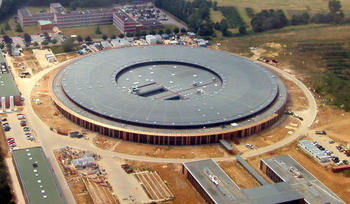
 The Synchrotron SOLEIL is a 3rd generation synchrotron radiation facility in operation since 2007. In 2009, 1,719 users have performed 348 experiments on the 14 first open beamlines. Currently, SOLEIL is delivering photons to 21 beamlines with a current of 400 mA in top-up mode: 17 beamlines are open to users and 4 under commissioning. In addition, new challenging beamlines are under construction or under design, while SOLEIL is developing technical platforms as the IPANEMA one for Cultural Heritage research. More than 2,000 users from France, Europe and other countries are expected per year to perform experiments in various fields as surface and material science, environmental and earth science, very dilute species and biology. Responsibility for operating the SOLEIL facility is under the charge of its two shareholders, the CNRS (72%) and the CEA (28%). SOLEIL is involved in bilateral partnerships with more than 12 Universities and Research Institutes and about 30 collaborative projects for ANR and the European Research Programmes have been successfully supported. On the Computing and Controls side, a great effort has been made very early to standardise hardware and software, keeping in mind developments reusability and easy maintenance. The data acquisition system of each Beamline is based on the TANGO system, also used for the Machine control. All beamlines can automatically generate data in the NeXus standard format, ensuring easier data management and contributing to future interoperability with other research facilities. NeXus files are stored via the storage infrastructure managed with the Active Circle software, handling data availability, data replication on disks and tapes, lifecycle management. Data are accessible from the beamlines as well as from any office in the buildings, with security based on LDAP authentication. A remote access search and data retrieval system, TWIST, allows users to perform complex queries to find pertinent data and to download all or parts of a NeXus file. Data post-processing is handled either on local PCs, or on a beamline compute cluster (if required for experiment control), or on a central HPC system.
The Synchrotron SOLEIL is a 3rd generation synchrotron radiation facility in operation since 2007. In 2009, 1,719 users have performed 348 experiments on the 14 first open beamlines. Currently, SOLEIL is delivering photons to 21 beamlines with a current of 400 mA in top-up mode: 17 beamlines are open to users and 4 under commissioning. In addition, new challenging beamlines are under construction or under design, while SOLEIL is developing technical platforms as the IPANEMA one for Cultural Heritage research. More than 2,000 users from France, Europe and other countries are expected per year to perform experiments in various fields as surface and material science, environmental and earth science, very dilute species and biology. Responsibility for operating the SOLEIL facility is under the charge of its two shareholders, the CNRS (72%) and the CEA (28%). SOLEIL is involved in bilateral partnerships with more than 12 Universities and Research Institutes and about 30 collaborative projects for ANR and the European Research Programmes have been successfully supported. On the Computing and Controls side, a great effort has been made very early to standardise hardware and software, keeping in mind developments reusability and easy maintenance. The data acquisition system of each Beamline is based on the TANGO system, also used for the Machine control. All beamlines can automatically generate data in the NeXus standard format, ensuring easier data management and contributing to future interoperability with other research facilities. NeXus files are stored via the storage infrastructure managed with the Active Circle software, handling data availability, data replication on disks and tapes, lifecycle management. Data are accessible from the beamlines as well as from any office in the buildings, with security based on LDAP authentication. A remote access search and data retrieval system, TWIST, allows users to perform complex queries to find pertinent data and to download all or parts of a NeXus file. Data post-processing is handled either on local PCs, or on a beamline compute cluster (if required for experiment control), or on a central HPC system.
